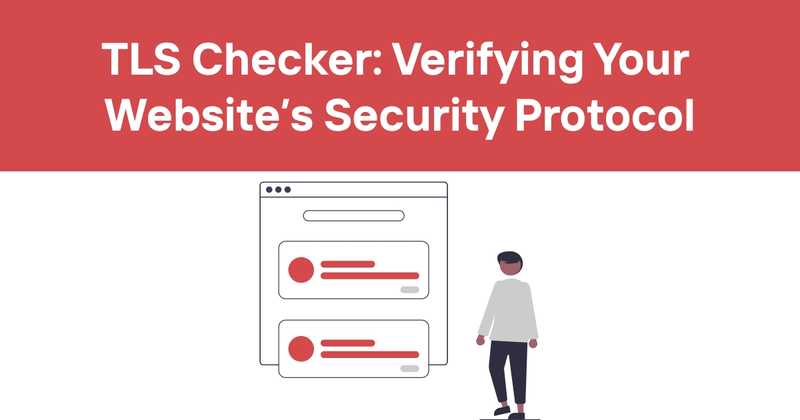TLS Checker: Verifying Your Website’s Security Protocol
TLS, or Transport Layer Security, is the backbone of secure communication on the internet. As a software developer, ensuring your website uses the latest TLS version is crucial for protecting user data and maintaining trust. But how can you quickly check which TLS version your site supports? Let's dive into TLS checkers and how to use them effectively.
Table of Contents
- What is TLS?
- Why TLS Versions Matter
- How to Check TLS Version
- Popular TLS Checker Tools
- Interpreting TLS Checker Results
- Common TLS Configuration Issues
- Upgrading Your TLS Version
- TLS Best Practices for Developers
- The Future of TLS
- TLS Checking with Odown
What is TLS?
TLS is a cryptographic protocol designed to provide secure communication over a computer network. It's the successor to SSL (Secure Sockets Layer) and is used to encrypt data transmitted between web browsers and servers.
The protocol works by:
- Authenticating the server (and optionally the client)
- Negotiating a shared secret key
- Encrypting subsequent communications
TLS has gone through several versions, with each iteration improving security and performance. The current versions in use are TLS 1.2 and TLS 1.3, with older versions (TLS 1.0 and 1.1) considered insecure and deprecated.
Why TLS Versions Matter
Using an up-to-date TLS version is critical for several reasons:
- Security: Newer versions patch vulnerabilities found in older ones.
- Performance: TLS 1.3, for example, reduces handshake latency.
- Compliance: Many regulatory standards require the use of current TLS versions.
- Browser Support: Modern browsers may warn users or block access to sites using outdated TLS.
As a developer, staying current with TLS versions helps protect your users and maintain the credibility of your site.
How to Check TLS Version
Checking your site's TLS version is straightforward. Here's a step-by-step guide:
- Choose a TLS checker tool (we'll cover some options shortly).
- Enter your website's domain name.
- Initiate the scan.
- Review the results, which typically include:
- Supported TLS versions
- SSL/TLS certificate information
- Cipher suites
- Potential vulnerabilities
It's that simple! But let's look at some specific tools you can use.
Popular TLS Checker Tools
Several online tools can check your site's TLS configuration. Here are a few popular options:
1. Qualys SSL Labs
Qualys SSL Labs offers a comprehensive SSL/TLS test. It's free, doesn't require installation, and provides detailed results.
To use it:
- Go to https://www.ssllabs.com/ssltest/
- Enter your domain name
- Click "Submit"
The scan may take a few minutes. Once complete, you'll see a detailed report including supported protocols, cipher suites, and an overall rating.
2. Odown SSL Checker
Odown's SSL Checker is another excellent option. It's user-friendly and provides quick results. We'll dive deeper into this tool later.
3. TestSSLServer
For those who prefer command-line tools, TestSSLServer is a Java-based option. It's particularly useful for batch testing multiple servers.
To use it:
- Download the JAR file
- Run:
java -jar TestSSLServer.jar example.com 443
This tool provides a quick overview of supported protocols and cipher suites.
Interpreting TLS Checker Results
After running a TLS check, you'll be presented with a wealth of information. Here's how to make sense of it:
Supported Protocols
Look for TLS 1.2 and TLS 1.3. If you see SSL 3.0, TLS 1.0, or TLS 1.1, it's time to upgrade your configuration.
Cipher Suites
These are the encryption algorithms used. Modern, secure cipher suites should be prioritized. Look for suites using:
- AES-GCM for encryption
- ECDHE for key exchange
- SHA-256 or higher for message authentication
Certificate Information
Check that your certificate is:
- Valid (not expired)
- Issued by a trusted Certificate Authority
- Uses a strong key (RSA 2048-bit or higher, or ECDSA)
Vulnerabilities
Good TLS checkers will flag known vulnerabilities. Pay attention to these and address them promptly.
Common TLS Configuration Issues
When checking your TLS configuration, you might encounter some common issues:
-
Outdated Protocols: Supporting TLS 1.0 or 1.1 is a red flag.
-
Weak Cipher Suites: Using outdated ciphers like RC4 or 3DES is insecure.
-
Certificate Problems: These could include expired certificates, weak keys, or untrusted issuers.
-
Missing Server Name Indication (SNI): This can cause issues with virtual hosting.
-
Insufficient Forward Secrecy: Not prioritizing ECDHE key exchange algorithms reduces security.
-
Vulnerable to Known Attacks: Watch for flags indicating POODLE, BEAST, or Heartbleed vulnerabilities.
Addressing these issues promptly is crucial for maintaining a secure website.
Upgrading Your TLS Version
If your TLS checker reveals that you're using an outdated version, it's time to upgrade. Here's a general process:
-
Check Server Software: Ensure your web server software (Apache, Nginx, etc.) supports modern TLS versions.
-
Update Configuration: Modify your server configuration to enable TLS 1.2 and 1.3. For example, in Nginx:
- Update Cipher Suites: Configure strong, modern cipher suites. Here's an example for Apache:
-
Test Configuration: Use a TLS checker to verify your changes.
-
Monitor Client Impact: Watch for any issues with older clients that might not support newer TLS versions.
Remember, the exact steps may vary depending on your server setup. Always refer to your server software's documentation for specific instructions.
TLS Best Practices for Developers
As a developer, there are several best practices you should follow to ensure optimal TLS implementation:
-
Keep Software Updated: Regularly update your server software and libraries to get the latest security patches.
-
Use Strong Certificates: Choose certificates with at least 2048-bit RSA keys or 256-bit ECDSA keys.
-
Implement HSTS: HTTP Strict Transport Security (HSTS) tells browsers to always use HTTPS for your domain.
-
Enable Perfect Forward Secrecy: This protects past communications even if your private key is compromised.
-
Configure OCSP Stapling: This improves performance and privacy when checking certificate validity.
-
Regularly Test Your Configuration: Use TLS checkers periodically to catch any issues.
-
Plan for Certificate Expiration: Set up reminders or automated processes to renew certificates before they expire.
-
Consider CAA Records: Certificate Authority Authorization (CAA) DNS records specify which CAs can issue certificates for your domain.
By following these practices, you'll significantly enhance your website's security posture.
The Future of TLS
TLS continues to evolve. While TLS 1.3 is the current standard, work is ongoing to improve the protocol further. Some areas of focus include:
- Post-Quantum Cryptography: Preparing for the threat of quantum computers.
- Improved Privacy: Reducing the amount of information leaked during the handshake process.
- Performance Enhancements: Further reducing latency and computational overhead.
As a developer, staying informed about these developments will help you keep your implementations secure and efficient.
TLS Checking with Odown
While we've discussed several TLS checking tools, Odown deserves special mention. As a comprehensive website monitoring solution, Odown offers robust SSL/TLS monitoring capabilities.
With Odown, you can:
- Continuously monitor your SSL/TLS configuration
- Receive alerts about expiring certificates
- Track changes in your TLS implementation over time
- Generate reports for compliance purposes
But Odown goes beyond just TLS checking. It provides:
- Website and API uptime monitoring
- Public status pages for transparent communication with users
- Performance monitoring to catch issues before they impact users
By using Odown, you're not just checking your TLS configuration — you're implementing a holistic approach to website reliability and security.
To get started with Odown:
- Sign up for an account at odown.com
- Add your website to the monitoring dashboard
- Configure your SSL/TLS monitoring preferences
- Set up alerts for any issues
With Odown, you can rest easy knowing your website's security is being continuously monitored.
In conclusion, regularly checking and updating your TLS configuration is a crucial part of web development and maintenance. By using tools like TLS checkers and comprehensive monitoring solutions like Odown, you can ensure your website remains secure, compliant, and trustworthy. Remember, in the world of web security, vigilance is key. Stay informed, stay updated, and keep your users' data safe.



